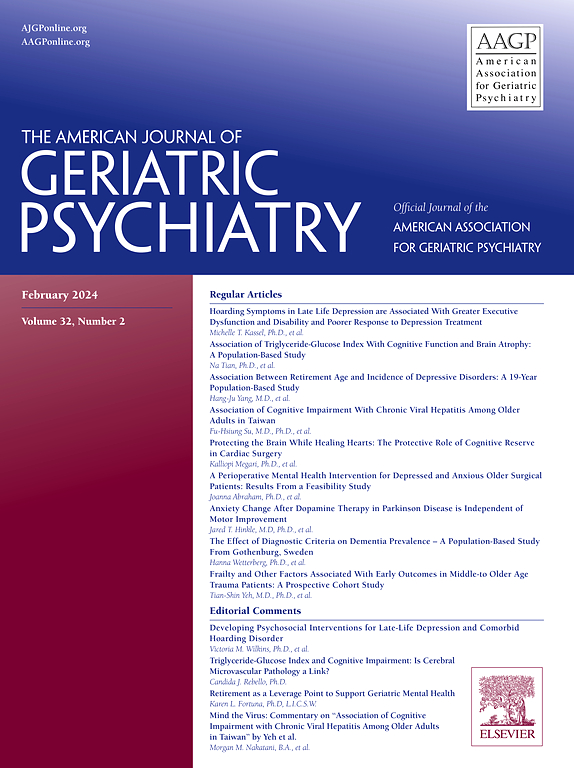31. 长期护理环境中迟发性运动障碍的负担:来自美国索赔数据的真实研究结果
IF 3.8
2区 医学
Q1 GERIATRICS & GERONTOLOGY
引用次数: 0
摘要
迟发性运动障碍(TD)是一种与抗精神病药物暴露相关的持续性运动障碍,可对社交、身体和情感功能产生致残性影响。老年人患TD的风险更高,可能特别容易受到其身体影响(例如,吞咽困难),这可能使长期护理(LTC)环境中的临床管理复杂化。然而,关于慢性阻塞性肺病的患病率和负担的数据是有限的。因此,一项现实世界的研究使用美国(US)的索赔数据来描述LTC环境中TD患者的特征。方法使用STATinMED真实世界数据洞察数据库进行分析,该数据库捕获了80%的美国索赔数据。研究期定义为2016年1月至2022年12月(含)。对研究期间LTC住院≥1次且ICD-10代码指示TD (G24.01)的患者进行识别,并对研究期间每次LTC住院的LTC设置进行描述性分析。在符合更严格的纳入标准的患者亚群中,描述性地分析了与合并症、药物使用和医疗访问相关的其他分析:2017年1月至2021年12月(识别期)≥1次LTC住院,“指数住院”定义为首次LTC住院;ICD-10代码G24.01在索引停留时或之前;并且连续获得1年的医疗和药品福利在指数前和指数后的1年。结果20,183例患者在研究期间有ICD-10代码,表明TD和≥1次LTC住院。熟练护理机构是最常见的LTC住宿类型,在研究期间有14235(70.5%)患者在熟练护理机构住宿≥1个。长期居住在疗养院(55.2%)和辅助生活设施(20.4%)也很常见。在2294例符合附加分析标准的患者中,1483例(64.6%)年龄≥65岁,1544例(67.3%)为女性。Charlson合并症指数(CCI)平均(±SD)为3.72(±4.2)分,其中753例(32.8%)CCI评分≥4分,表明合并症负担高,死亡风险增加。常见的合并症包括情绪障碍(66.1%)、精神分裂症(38.8%)、睡眠障碍(35.0%)、药物滥用(28.4%)、尿路感染(26.7%)和吞咽困难(18.5%)。使用抗抑郁药(56.1%)、抗惊厥药(52.3%)、抗精神病药(50.4%)和抗胆碱能药(50.0%)较为常见。此外,多种用药也很常见,47.9%的患者服用了≥3种可能增加老年人跌倒或认知障碍风险的药物(如抗胆碱能药、抗惊厥药、抗组胺药、苯二氮卓类药物、镇静催眠药)。指标LTC住院后1年内,1085例(47.3%)患者急诊次数≥1次,中位数为2次/例,至首次就诊的中位数时间为143天。目前正在对抗胆碱能药物的使用、滑倒和跌倒的发生率以及医疗资源的利用进行额外的纵向现实世界分析。结论在对现实索赔数据的分析中,熟练的护理机构是TD患者最常见的LTC住宿类型。LTC环境中的TD患者往往年龄较大,有较高的合并症负担和多重用药。使用导致TD(抗精神病药)或加重TD(抗胆碱能药)的药物很常见,去急诊室也是如此。这些数据表明,需要特别关注LTC环境中TD患者的临床负担和药物治疗,特别是老年人。本文章由计算机程序翻译,如有差异,请以英文原文为准。
31. THE BURDEN OF TARDIVE DYSKINESIA IN LONG-TERM CARE SETTINGS: RESULTS FROM A REAL-WORLD STUDY OF UNITED STATES CLAIMS DATA
Introduction
Tardive dyskinesia (TD), a persistent movement disorder associated with antipsychotic exposure, can have disabling impacts on social, physical, and emotional functioning. Older adults have a higher risk for TD and may be particularly vulnerable to its physical impacts (e.g., difficulty swallowing), potentially complicating clinical management in long-term care (LTC) settings. However, data on the prevalence and burden of TD in LTC settings are limited. Therefore, a real-world study was conducted using United States (US) claims data to characterize patients with TD in LTC settings.
Methods
The STATinMED Real-World Data Insights Database, which captures 80% of US claims data, was used for analysis. The study period was defined as Jan 2016-Dec 2022 (inclusive). Patients with ≥1 LTC stay and an ICD-10 code indicative of TD (G24.01) during the study period were identified and analyzed descriptively by LTC setting for each LTC stay during the study period. Additional analyses related to comorbidities, medication use, and healthcare visits were analyzed descriptively in a subpopulation of patients who met a more stringent set of inclusion criteria: ≥1 LTC stay from Jan 2017 to Dec 2021 (identification period), with “index stay” defined as the first LTC stay; ICD-10 code of G24.01 on or before the index stay; and continuous capture of medical and pharmacy benefits for 1 year pre-index stay and 1 year post-index stay.
Results
20,183 patients had an ICD-10 code indicative of TD and ≥1 LTC stay during the study period. Skilled nursing facilities were the most common type of LTC stay, with 14,235 (70.5%) patients having ≥1 skilled nursing facility stay during the study period. LTC stays in nursing homes (55.2%) and assisted living facilities (20.4%) were also common. Among 2,294 patients who met the criteria for additional analysis, 1,483 (64.6%) were ≥65 years and 1,544 (67.3%) were female. The mean (±SD) Charlson Comorbidity Index (CCI) score was 3.72 (±4.2), and 753 (32.8%) had a CCI score ≥4, indicating high comorbidity burden and increased mortality risk. Common comorbidities included mood disorders (66.1%), schizophrenia (38.8%), sleep disorders (35.0%), substance abuse (28.4%), urinary tract infections (26.7%), and dysphagia (18.5%). The use of antidepressants (56.1%), anticonvulsants (52.3%), antipsychotics (50.4%), and anticholinergics (50.0%) was common. Moreover, polypharmacy was common, with 47.9% of patients being prescribed ≥3 medications that may increase risk of falls or cognitive impairment in elderly adults (e.g., anticholinergics, anticonvulsants, antihistamines, benzodiazepines, sedative-hypnotics). Within 1 year after the index LTC stay, 1,085 (47.3%) patients had ≥1 emergency department (ED) visit, with a median of 2 visits/patient and median time to first visit of 143 days. Additional longitudinal real-world analyses on anticholinergic use, the prevalence of slips and falls, and healthcare resource utilization are currently being performed.
Conclusions
In this analysis of real-world claims data, skilled nursing facilities were the most common type of LTC stay for patients with TD. Patients with TD in LTC settings tended to be older and have high comorbidity burden and polypharmacy. Use of medications that cause TD (antipsychotics) or worsen TD (anticholinergics) was common, as were ED visits. These data indicate a need for special attention to the clinical burdens and pharmacological treatments of patients with TD in LTC settings, particularly older adults.
求助全文
通过发布文献求助,成功后即可免费获取论文全文。
去求助
来源期刊
CiteScore
13.00
自引率
4.20%
发文量
381
审稿时长
26 days
期刊介绍:
The American Journal of Geriatric Psychiatry is the leading source of information in the rapidly evolving field of geriatric psychiatry. This esteemed journal features peer-reviewed articles covering topics such as the diagnosis and classification of psychiatric disorders in older adults, epidemiological and biological correlates of mental health in the elderly, and psychopharmacology and other somatic treatments. Published twelve times a year, the journal serves as an authoritative resource for professionals in the field.

 求助内容:
求助内容: 应助结果提醒方式:
应助结果提醒方式:


